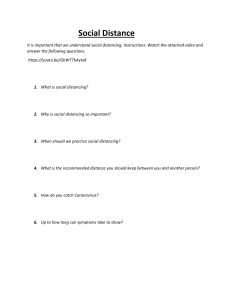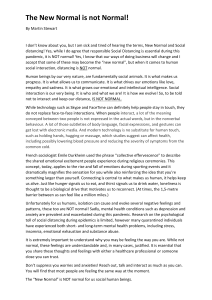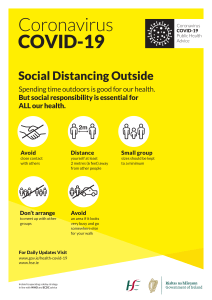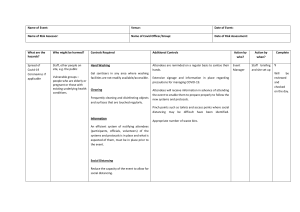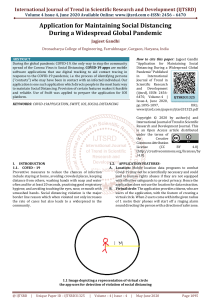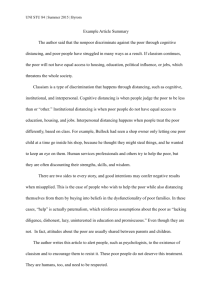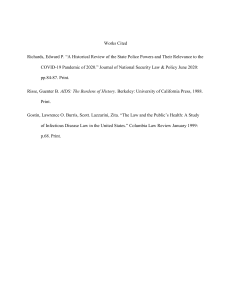Stringency in policy responses to Covid-19 pandemic and social distancing behavior in selected countries
advertisement
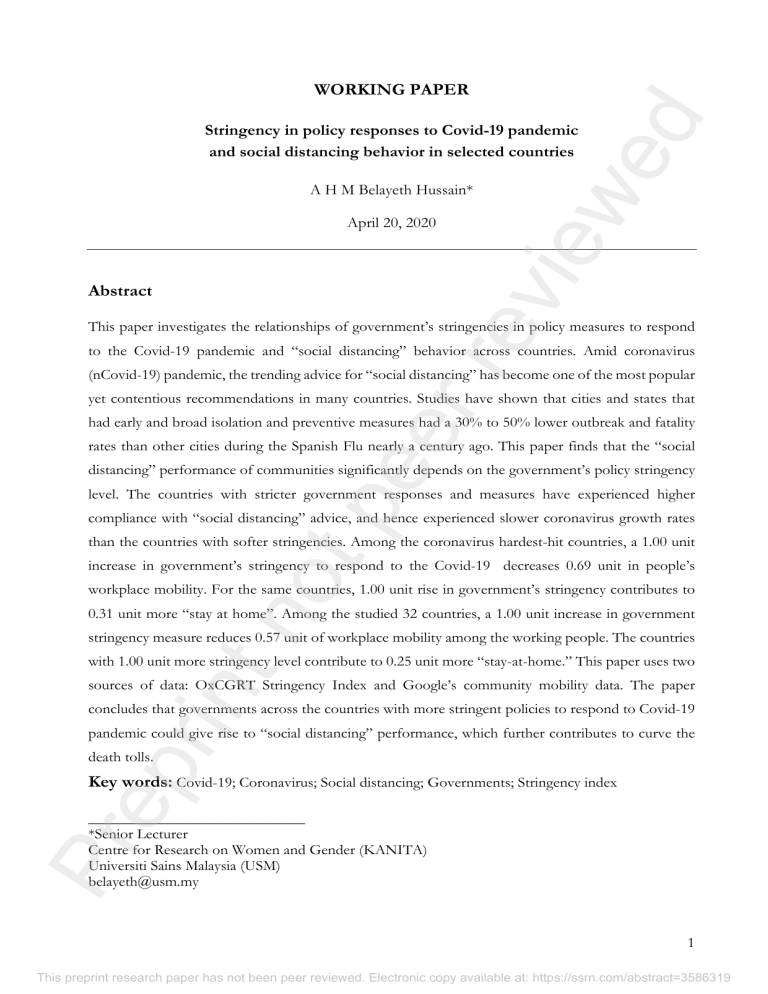
pe er re vie we Stringency in policy responses to Covid-19 pandemic and social distancing behavior in selected countries d WORKING PAPER A H M Belayeth Hussain* April 20, 2020 Abstract This paper investigates the relationships of government’s stringencies in policy measures to respond to the Covid-19 pandemic and “social distancing” behavior across countries. Amid coronavirus (nCovid-19) pandemic, the trending advice for “social distancing” has become one of the most popular yet contentious recommendations in many countries. Studies have shown that cities and states that had early and broad isolation and preventive measures had a 30% to 50% lower outbreak and fatality rates than other cities during the Spanish Flu nearly a century ago. This paper finds that the “social distancing” performance of communities significantly depends on the government’s policy stringency level. The countries with stricter government responses and measures have experienced higher compliance with “social distancing” advice, and hence experienced slower coronavirus growth rates ot than the countries with softer stringencies. Among the coronavirus hardest-hit countries, a 1.00 unit increase in government’s stringency to respond to the Covid-19 decreases 0.69 unit in people’s workplace mobility. For the same countries, 1.00 unit rise in government’s stringency contributes to tn 0.31 unit more “stay at home”. Among the studied 32 countries, a 1.00 unit increase in government stringency measure reduces 0.57 unit of workplace mobility among the working people. The countries with 1.00 unit more stringency level contribute to 0.25 unit more “stay-at-home.” This paper uses two rin sources of data: OxCGRT Stringency Index and Google’s community mobility data. The paper concludes that governments across the countries with more stringent policies to respond to Covid-19 pandemic could give rise to “social distancing” performance, which further contributes to curve the ep death tolls. Key words: Covid-19; Coronavirus; Social distancing; Governments; Stringency index Pr ____________________________ *Senior Lecturer Centre for Research on Women and Gender (KANITA) Universiti Sains Malaysia (USM) belayeth@usm.my 1 This preprint research paper has not been peer reviewed. Electronic copy available at: https://ssrn.com/abstract=3586319 d 1. Introduction Amid coronavirus (nCovid-19) pandemic, the trending advice for "social distancing” has become one pe er re vie we of the most popular yet contentious recommendations in many countries. Studies have shown that cities and states that had early and broad isolation and preventive measures had a 30% to 50% lower outbreak and fatality rates than other cities during the Spanish Flu nearly a century ago. Studies investigated the hypothesis that the Spanish Flu multiple waves were caused by people avoiding potentially infectious contacts, a behavior termed “social distancing” interventions, which could play a significant role in mitigating the public health impact of future influenza pandemics (Caley et al., 2007). During this current pandemic situation around the world, some studies also have found a positive impact of “social distancing” to flatten the curve of coronavirus outbreak. People’s restricted mobility to workplaces and other commonly traveled places help reduce the coronavirus rise (Yilmazkuday, 2020). This can have a better outcome when government measures across the countries become more stringent as the outbreak gets spiked (Hale et.al., 2020). To restrict people’s mobility during the pandemic, government’s policy choices play a decisive role that helps curve the rise of the ot death toll. Governments’ decisions on social distancing, movement restrictions, and lockdowns have negative associations with people’s mobility to retail and recreation centers, groceries and pharmacies, tn parks, transit stations, and workplaces (Hussain, 2020). The same decisions have a positive association with people’s stay-at-home behavior. The World Health Organization (WHO) recommends people to rin maintain at least one-meter distance between persons (WHO, 2020). However, this advice seems purely a "physical distancing" between persons (among whom there might be a potential carrier of coronavirus). On the other hand, the Centers for Disease Control and Prevention (CDC) explains ep "social distancing" which they also call "physical distancing" as a way of people’s mobility to keep them distant from others (CDC, 2020). This definition includes at least two meters distance from other Pr people; to avoid gathering in groups; and staying out of crowded places and mass gatherings (CDC, 2020). Some researchers argue that the term "social distancing" should be replaced with “spatial distancing” along with “social closeness”. They recommend that public health advice should approach 2 This preprint research paper has not been peer reviewed. Electronic copy available at: https://ssrn.com/abstract=3586319 the threat of Covid-19 by promoting "spatial distance" together with "social closeness" (Abel and pe er re vie we d McQueen, 2020). As governments around the world have responded to the Covid-19 pandemic, the latest information about their policies is essential to offer further avenues. Oxford Covid-19 Government Response Tracker (OxCGRT) has developed a new robust index that demonstrates levels of policy measures that the governments across countries have taken to tackle the spread of pandemic (Hale et al., 2020). The authors of OxCGRT have collected various policy responses to Covid-19 pandemic based on 11 indicators, namely, school closure, workplace closure, cancellation of public events, closure of public transports, closure of public campaigns, imposing movement restrictions, imposing international travel controls, introducing fiscal and monetary measures, emergency investment in health care, investment in vaccines, testing policy, and, contact tracing, etc. Google (2020) has introduced a report on people’s mobility as a response to social distancing advice during the Covid-19 pandemic. This report is made possible to track people’s movement using location ot services in the countries where this service is available. Google identifies six major locations where people are used to traveling and moving in their everyday needs. The six defined areas are: retail and tn recreation centers that include restaurants cafes, shopping centers, theme parks, museums, libraries, and movie theatres; groceries and pharmacies that include the locations of grocery markets, food rin warehouses, farmers markets, food shops, drug stores, and pharmacies; various parks that include national parks, public beaches, plazas, and public gardens; transit stations are the locations including ep subways, bus and train stations; workplaces where people use to travel during workdays; and, residential places where people stay. Pr This paper finds that the “social distancing” performance of communities significantly depends on the government’s policy stringency level. To define “social distancing,” this study considers three areas of people’s mobility during the pandemic. The “social distancing” indicators of people’s movement are 3 This preprint research paper has not been peer reviewed. Electronic copy available at: https://ssrn.com/abstract=3586319 — “stay-at-home,” “mobility towards workplaces,” and “mobility towards public parks.” The study d finds that the countries with stricter government policy responses and measures have experienced pe er re vie we higher compliance with “social distancing” advice, and hence experienced a slower coronavirus growth rate than the countries with softer stringencies. Among the coronavirus hardest-hit countries, a 1.00 unit increase in government’s stringency to respond to the Covid-19 decreases 0.69 unit in people’s workplace mobility. For the same countries, 1.00 unit increase in government’s stringency contributes to 0.31 unit more “stay at home.” Among the studied 32 countries, a 1.00 unit increase in government stringency measure reduces 0.57 unit of workplace mobility among the working people. For these countries, with 1.00 unit more stringency level contributes to 0.25 unit more “stay-at-home.” This paper utilizes two sources of data: OxCGRT Stringency Index and Google’s community mobility data. 2. Data This paper appropriates two sources of data: OxCGRT Stringency Index (Hale et al., 2020) and Google’s data (2020) on community mobility (Chan et al., 2020). During the pandemic, the ot governments across countries have declared and implemented some initiatives that include social distancing, movement restrictions, public health measures, socio-economic measures, and lockdown tn declarations. ACAPS (2020) has compiled all the measures implemented by governments worldwide. As a relatively robust way of indexing, the OxCGRT has developed a stringency index for each rin countries depending on its policy responses to the Covid-19 pandemic. Using 11 indicators on governments’ responses to Covid-19, the OxCGRT developed a “0 to 100 point Index” for countrylevel stringency. On the other, Google mobility data reports how people’s community mobility at ep different places has changed compared to a baseline. As explained by Google, the benchmark is a median value of the five weeks, January 3, 2020, to February 6, 2020. Provided that data from both Pr sources are available from February 16, 2020, to March 29, 2020, this paper chooses 32 countries from all geographic regions. The selected countries are ­— Australia, Austria, Belgium, Brazil, Canada, Denmark, Finland, France, Germany, India, Ireland, Israel, Italy, Japan, Malaysia, Netherlands, New 4 This preprint research paper has not been peer reviewed. Electronic copy available at: https://ssrn.com/abstract=3586319 Zealand, Philippines, Norway, Singapore, Portugal, Saudi Arabia, South Africa, South Korea, Spain, pe er re vie we d Sweden, Switzerland, Taiwan, Thailand, Turkey, United Kingdom, United States of America. 3. Results Stringent measures and social distancing Figure 1 demonstrates different governments’ stringencies to ensure social distancing across countries over time (February 16, 2020, to March 29, 2020). Australia, Ireland, Japan, Singapore, South Korea, Sweden, Taiwan, Thailand, United Kingdom, and the United States had been experiencing a softer level of stringencies than the other studies countries mentioned in the Figure. On the other, the countries with Stringency Index over 90 and above are Austria, Denmark, Finland, France, India, Israel, Italy, Malaysia, Netherlands, New Zealand, Norway, Philippines, Saudi Arabia, South Africa, Spain, and Turkey. Among the coronavirus hardest-hit countries, the United States and the United Kingdom had the least level of stringencies from their governments. As of April 26, 2020, the Unites States share around one-fourth of total death tolls in the world, while among the European nations, ot United Kingdom has the third highest deaths per million populations of the country. Asian countries are among the top, where governments have stricter advice for their citizens. India, Israel, Malaysia, tn the Philippines, Saudi Arabia, and Turkey are among them. However, some Asian nations, for example, Japan, Singapore, South Korea, and Taiwan, had softer advice for their citizens amid the Covid-19 pandemic. Singapore, which had a minimal number of confirmed cases up until late March 2020 has Pr ep rin now the highest among the ASEAN countries. 5 This preprint research paper has not been peer reviewed. Electronic copy available at: https://ssrn.com/abstract=3586319 d pe er re vie we ot tn Figure 1: Stringencies across countries Figure 2 brings together two different charts demonstrating the state of stringencies and resultant rin social distancing performances across the countries. In the first chart, scatters show the linear increase of stringency levels in the countries. The same chart also shows a sharp decline in people’s workplace presence and appearance in public places. Conversely, people’s propensity to stay at home had ep increased compared to their baseline time (median score of previous months). The chart indicates that from mid-February until mid-March 2020, the growth rate of confirmed coronavirus cases has risen Pr that follow a slow decline after mid-March. As time advanced, the consequences of relative rise in the stringency levels of governments’ policies and pieces of advice fell into the reductions in citizen’s community mobility towards workplaces and public parks that indicate the sharp rise in social 6 This preprint research paper has not been peer reviewed. Electronic copy available at: https://ssrn.com/abstract=3586319 distancing performances. As the chart shows, after mod-March until the end of the month, another d indicator of social distancing, people’s stay-at-home has increased than the baseline period. From all pe er re vie we five lines in the chart, the paper infers that the stricter the government rules, the more the social Pr ep rin tn ot distancing performance can achieve by a country. Figure 2: Governments' stringencies and social distancing 7 This preprint research paper has not been peer reviewed. Electronic copy available at: https://ssrn.com/abstract=3586319 In Figure 2, the second chart shows two comparative regression lines on top of a scatter plot of d stringency levels across countries. Using the data wrangling and tidying procedures in R programming, pe er re vie we I made another group of data-frame that has observations from the coronavirus hardest-hit countries. They are United States, United Kingdom, Italy, France, Germany, and Spain. In the chart, the “blue” linear regression line indicates overall (32 countries) predicted increase in people’s “stay-at-home” Pr ep rin tn ot behavior. Figure 3: Governments' stringencies and social distancing 8 This preprint research paper has not been peer reviewed. Electronic copy available at: https://ssrn.com/abstract=3586319 as a result of stricter public health advices from the government. The “red” regression line indicates d the predicted contingency for the top hit six countries. The chart confirms that the coronavirus pe er re vie we hardest-hit countries would have better “stay-at-home” performance (as an indicator of social distancing) than the overall result of all 32 countries. For them, a 1 unit increase in stringencies of government measures results in a 0.31 unit increase in “stay-at-home (Table 2). This result is statistically significant, with a p-value of 0.000 and R-squared of0.77 (Table 2). On the same social performance indicator, among 32 countries, with 1 unit increase in stringencies of government measures results in a 0.25 unit reduction in “stay-at-home.” This result is also statistically significant, with a p-value of 0.000 and R-squared of 0.66. Likewise, Figure 3 brings together two charts demonstrating the level of stringencies and consequent social distancing performances across the countries. In the first chart, the “blue” linear regression line indicates a sharp reduction in people’s mobility towards workplaces. The findings infer that this reduction is a result of stricter public health advice from the government. However, when it comes to comparing the top six affected countries, it is seen that the hardest-hit countries have even sharper ot decline than the overall fall in workplace presence. The “red” regression line indicates the predicted tn dependency of people’s restricted mobility towards workplaces on the stringency levels of the governments' measures to curve the Covid-19 pandemic in the hardest hit six countries. The lines in this chart confirm that the coronavirus hardest-hit countries would have a sharper decline in workplace rin presence (as an indicator of social distancing) than the overall result of all 32 countries. For 32 countries, with 1 unit increase of stringencies in government measures reduces -0.57 (p-value = 0.000; ep R-squared = 0.58) unit of workplace presence during the pandemic (Table 1). For the hardest-hit six countries, a 1 unit increase in stringencies in government measures leads a -0.69 unit decline (p-value Pr = 0.000; R-squared = 0.75) in community mobility towards workplaces (Table 2). The second chart demonstrates that the studied countries have experience of controlled community mobility towards public parks. This result also has the same confirmation as it is showed in the first 9 This preprint research paper has not been peer reviewed. Electronic copy available at: https://ssrn.com/abstract=3586319 pe er re vie we than all 32 countries. However, the trend is similar in both groups of countries. d chart — the hardest-hit counties have responded to stricter stringencies of public health advice more Stringencies and social distancing in hardest hit countries Figure 4 has four charts that demonstrate the effects of stringencies in government decisions on the Covid-19 case growth rate and social distancing performances in selected six countries. All the four charts present linear regression lines that indicate the dependencies of social distancing performances and coronavirus case growth on the stringency levels. The first chart shows that a linear increase in confirm case growth rate as stringency levels increase. However, this trend is slow and steady. Among the hardest-hit countries, this rate grows with a higher rate than the average growth rate in all 32 countries included in this study. Italy, Spain, and France had the strictest levels of government measures for public health advice. On the other, the United States and the United Kingdom had softer levels of stringencies with a higher rate of fatalities than the overall average. The second chart shows that the nationals of Italy, Spain, and France had the highest number of people who had stayed at home during the observed days in February and March 2020. With the stringency level of around 77, ot 20% more people had stayed at home in the United States, and in Germany. In contrast, with the tn stringency levels of nearly 100, approximately 38% more people had stayed at home than the previous base month. In the third chart, as the stringency levels grew up, people’s mobilities towards workplaces were restricted in six selected countries. rin Like the other two charts I discussed earlier, Italy, Spain, and France performed best with the highest levels of stringencies. With approximately the same stringency level as it is with the United States and ep Germany, the United Kingdom showed much more reductions in workplace presence. However, the United States had the least performance in decline in workplace mobility than their counterparts. In Pr the fourth chart, the trend remains the same for selected countries with an exception for the United States. While in the other five countries, with higher levels of stringencies, people’s community mobilities to public parks were much lower, the United States had the experience of higher flows to parks even than the predicted line. 10 This preprint research paper has not been peer reviewed. Electronic copy available at: https://ssrn.com/abstract=3586319 d pe er re vie we ot tn Figure 4: Stringencies and social distancing in the hardest hit countries Table 1: Government stringency impacts on social distancing (32 countries) ep rin Model Workplaces ~ Stringency.Index Stay.at.Home ~ Stringency.Index Parks ~ Stringency.Index Estimate -0.69155 0.30668 -0.89580 Str. Err. 0.02476 0.01037 0.04240 R-sq. 0.7530 0.7736 0.6355 p-value 0.000 0.000 0.000 Table 2: Government stringency impacts on social distancing (6 hardest hit countries) Pr Model Workplaces ~ Stringency.Index Stay.at.Home ~ Stringency.Index Parks ~ Stringency.Index Estimate -0.56727 0.24996 -0.44415 Std. Err. 0.01315 0.00482 0.02203 R-sq. 0.5752 0.6623 0.2283 p-value 0.000 0.000 0.000 11 This preprint research paper has not been peer reviewed. Electronic copy available at: https://ssrn.com/abstract=3586319 Discussions and conclusions: d Governments’ policy measures on social distancing comprise of limiting public gatherings, school pe er re vie we closure, public service closure, and changes in prison-related policies. Social and economic measures (including governance) have decisions related to the declaration of the state of emergency, economic measures, activation of emergency administrative structures, and limiting export-import products. Governments’ initiatives related to public health introduce, implement and strengthen quarantine policies, awareness campaigns, general recommendations, public health systems, infection testing policies, psychological assistance, and medical social work. Globally, the governments also have introduced movement restriction policies that include surveillance and monitoring, border closures, visa restrictions, domestic travel restrictions, additional health documents upon arrivals, curfews, etc. Finally, with some exceptions, countries have declared partial and full lockdowns in state and territorial levels. The governments across the countries have declared and implemented some social, economic, public health, and governance-related decisions. The principal reason was to keep people away from the social ot contacts of others that help flatten out the rise of the covid-19 outbreak. From the data analyses, this paper explores that the people of most of the countries have responded to the governments’ initiatives tn to slow down the rise. As a result, people stay at home, reduce their mobility to workplaces and public parks. Social distancing actions and policies in response to the Covid-19 pandemic have substantial rin economic benefits. In essence, three to four months of moderate distancing would save 1.7 million lives, and the mortality benefit of moderate social distancing is about $ 8 trillion or around $60,000 per household in the United States (Greenstone et al., 2020). As the “social distancing” policies are of great ep importance among the political leaders, public health experts, and policymakers, some studies also urge that political leaders must introduce social-distancing policies that do not bias against any population Pr group in the country (Joseph et al., 2020). This fear extends further in other studies; for example, Stein (2020), in response to another study, Stein (2020) urges for a rationally layered social distancing. Because the Covid-19 pandemic disproportionately affects different groups of people, including age 12 This preprint research paper has not been peer reviewed. Electronic copy available at: https://ssrn.com/abstract=3586319 and health conditions of the victims. Therefore, a layered social distancing idea would be a decisive d determinant and predictor of successful pandemic preparedness, and to support social distancing for pe er re vie we vulnerable groups and to protect other individuals from the susceptible group (Stein, 2020). Therefore, the effectiveness and societal impact of social distancing will largely depend on the credibility of public health authorities, political leaders, and institutions (Joseph et al., 2020). From the analyses, this paper finds that the coronavirus hardest-hit countries have better “social distancing” performance, although they did not have as many stringencies as other nations did. However, some trends might be interesting for further studies — Nordic countries and some East Asian countries had fewer “social distancing” than the West and South European countries. This trend might have been in practice due to the hardest hit coronavirus disease situations in the West and South European nations. However, some Asian countries had experienced the highest level of stringencies even they did not face severe spreads during the studied periods. These may be the case of the nature and types of governments in the respective countries. With a variety of interventions and conditions, it is confirmed that the less strict the social distancing, the more time it will take for life to return to ot normal, and the more lives will be at risk (Cano et al., 2020). Therefore, whatever the government types, in this study on the stringencies and social distancing across countries, it is concluded that tn governments across the countries with more stringencies to respond to the Covid-19 pandemic could Pr ep rin give rise to “social distancing” performance which further contributes to curve the death tolls. 13 This preprint research paper has not been peer reviewed. Electronic copy available at: https://ssrn.com/abstract=3586319 d References: pe er re vie we Abel, Thomas., McQueen, David. 2020. The COVID-19 pandemic calls for spatial distancing and social closeness: not for social distancing!. 2020. International Journal of Public Health. https://doi.org/10.1007/s00038-020-01366-73456789 Assessment Capacities Projects (ACAPS). (2020). Data on governments’ measures. Accessed on March 30, 2020. https://data.humdata.org/organization/acaps. Centers for Disease Control and Prevention (CDC). (2020). https://www.cdc.gov/coronavirus/2019ncov/prevent-getting-sick/social-distancing.html Chan, H. F., A. Skali, and B. Torgler. (2020). A Global Dataset of Human Mobility for March 2020. Available at https://osf.io/gyafe/. Greenstone, Michael and Nigam, Vishan, Does Social Distancing Matter? (March 30, 2020). University of Chicago, Becker Friedman Institute for Economics Working Paper No. 2020-26. Available at SSRN: https://ssrn.com/abstract=3561244 or http://dx.doi.org/10.2139/ssrn.3561244 ot Hale, Thomas, Anna Petherick, Toby Phillips, Samuel Webster. “Variation in Government Responses to COVID-19” Version 4.0. Blavatnik School of Government Working Paper. April 7, 2020. Available: tn www.bsg.ox.ac.uk/covidtracker Hussain, A H M Belayeth, Do Governments’ Decisions on Social Distancing Flatten Out People’s Mobility During COVID-19 Pandemic? (April 12, 2020). Available at rin SSRN: https://ssrn.com/abstract=3574979 or http://dx.doi.org/10.2139/ssrn.3574979 Joseph A Lewnard, Nathan C Lo. (2020). Scientific and ethical basis for social-distancing interventions ep against COVID-19. Infectious Disease. The Lancet. https://doi.org/10.1016/S1473-3099(20)30190- Pr 0 Oliva Bendtsen Cano, Sabrina Cano Morales, and Claus Bendtsen. (2020). “COVID-19 Modelling: the Effects of Social Distancing”. medRxiv doi: https://doi.org/10.1101/2020.03.29.20046870 14 This preprint research paper has not been peer reviewed. Electronic copy available at: https://ssrn.com/abstract=3586319 Peter Caley, David J Philp and Kevin McCracken. (2007). Quantifying social distancing arising from d pandemic influenza. Journal of the Royal Society Interface. https://doi.org/10.1098/rsif.2007.1197 pe er re vie we Richard Stein. (2020). COVID-19 and rationally layered social distancing. The International Journal of clinical practice. https://doi.org/10.1111/ijcp.13501 World Health Organization (WHO). (2020). https://www.who.int/emergencies/diseases/novelcoronavirus-2019/advice-for-public (Accessed on April 1, 2020). Yilmazkuday, H. (2020). Stay-at-Home Works to Fight Against COVID-19: International Evidence from Google Mobility Data (April 9, 2020). Available at Pr ep rin tn ot SSRN: https://papers.ssrn.com/sol3/papers.cfm?abstract_id=3571708 15 This preprint research paper has not been peer reviewed. Electronic copy available at: https://ssrn.com/abstract=3586319
